51st Field Hospital Unit History
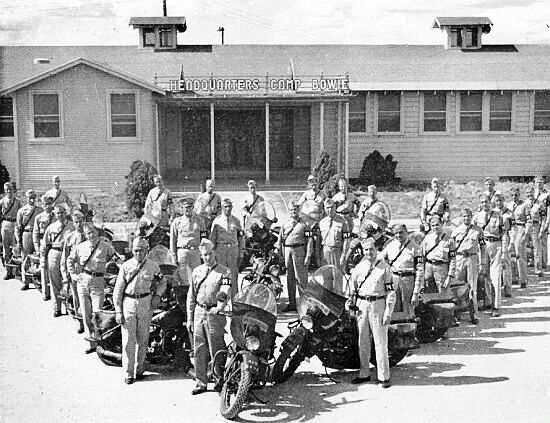
Photo illustrating the Headquarters building, Camp Bowie, Brownwood, Texas, where the 51st Field Hospital was activated on 10 September 1943.
Introduction & Activation:
The 51st Field Hospital was activated on 10 September 1943 at Camp Bowie, Brownwood, Texas (Armored Division Camp; total acreage 116,264; troop capacity 2,237 Officers and 43,247 Enlisted Men –ed), pursuant to authority contained in War Department Letter AG 322 (dated 31 August 1943) OB-I-SPMOU-M, Subject “Constitution and Activation of Medical Units on 10 and 25 September 1943”, dated 3 September 1943.
Captain Robey T. Sinclair, Jr., MC, O-369457, from the MTP (Mobilization Training Program), MRTC Camp Grant, Rockford, Illinois (Medical Replacement Training Center; total acreage 3,349; troop capacity 453 Officers and 20,836 Enlisted Men –ed) assumed command and began organizing the unit with an initial cadre of 1 additional Officer and 15 Enlisted Men.
During the remainder of the month of September, the joining of many scattered increments brought the Enlisted personnel to approximate T/O strength.
Training:
The following three months (October-November-December of 1943) were occupied with intensive routine training and personnel placements. All Technicians received regular and frequent didactic lectures concurrent with applied practical work at the Camp Bowie Station Hospital. Seventeen (17) Technicians were trained at various Army Technicians Schools. Cooks, drivers, and clerks received all the special training, instruction, and practice that available facilities at the Post allowed for. All personnel followed drill, physical conditioning, tent pitching, sanitation and field hygiene as well as participation in four different field problems involving simulated hospital setups in different locations. Training equipment and facilities proved adequate although most of the policies and practices emphasized were more applicable to the Pacific Area than to the European Theater of Operations.
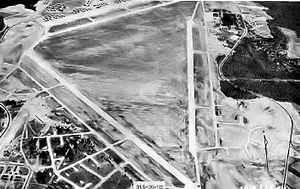
Aerial view of Laurinburg-Maxton Army Air Base taken on 26 February 1944. This is where the 51st Field Hospital trained during 2 weeks, December 1943-January 1944.
During this period most of the organization’s Medical Administrative Officers joined and assisted in the training program.
On 28 December 1943, the whole organization, with a strength of 7 Officers and 191 Enlisted Men entrained for Laurinburg-Maxton Army Air Force Base, Maxton, North Carolina.
Following a 2-week period of training involving mock-up air transport loading and rigging, the unit moved to Fort Bragg, Fayetteville, North Carolina (Field Artillery Replacement Training Center; total acreage 129,422; troop capacity 4,311 Officers and 76,175 Enlisted Men –ed) on 10 January 1944, where routine training was resumed with most of the technical personnel gaining more practical experience by working at the local Station Hospital # 2, Fort Bragg, Fayetteville, North Carolina.
Full authorized T/O strength was rapidly attained by the addition of extra Officers and Nurses. Alert orders for overseas movement, however, came before any regular organized training schedule for the MC and ANC Officers could be put into effect.
On 16 February 1944, the 51st Field Hospital, moved to its Staging Area at Camp Kilmer, Stelton, New Jersey, where the usual final changes and preparations of equipment and personnel were accomplished in time for embarkation.
Organization:
The standard Field Hospital organization consisted of 22 Officers – 18 Nurses – and 190 Enlisted Men (ref. T/O 8-510), which could care and treat some 400 (in fact specifically 380 –ed) patients. Field Hospitals were normally assigned or attached to a Field Army in accordance with policies of the local Theater Commander.
The three (3) separate Platoons included the following personnel: 4 or 5 Officers – 6 Nurses – 64 Enlisted Men. The 6 Nurses were divided in groups of six day Nurses and six night Nurses which meant that one ANC Officer per tent with two or three wardmen was to care for approximately thirty or more seriously wounded patients. In addition to the four Physicians, additional surgical teams (from the Auxiliary Surgical Groups) comprising 4 Surgeons and 4 Nurses, would assist with operations, in order to keep two or three operating tables busy 24 hours a day.
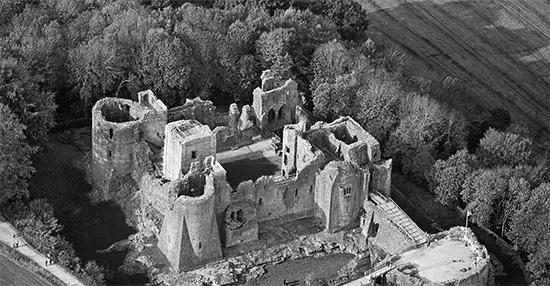
Ruins of Goodrich Castle, situated north of Goodrich village, Herefordshire, one of the attractions often visited by members of the 51st Field Hospital during their stay at Ross-on-Wye, Herefordshire, England. The site was part of the tourist attractions visited by servicemen when off-duty.
Commanding Officers – 51st Field Hospital
Major Robey T. Sinclair, Jr., MC
Lieutenant Colonel Harry P. Harper, MC
Lieutenant Colonel Orval T. Needels, MC
Captain D. S. Carroll, MC
Lieutenant Colonel David W. Clotfelder, MC
Major Freeman D. Love, MC
Captain Eugene D. Iden, DC
Principal Chief Nurses – 51st Field Hospital
Captain Myrtle T. Reynolds, ANC
First Lieutenant Lois K. Grant, ANC
Preparation for Overseas Movement:
Following final processing, the Hospital embarked for its overseas voyage on board USAT “Cristobal” departing New York Port of Embarkation, Zone of Interior, on 27 February 1944, arriving in the United Kingdom 9 March 1944, following an uneventful Atlantic crossing.
United Kingdom:
After a safe Atlantic crossing, the USAT “Cristobal” docked at Swansea, Wales, 9 March 1944. The unit only debarked the following day proceeding to Ross-on-Wye, Herefordshire, England, where it was to jointly occupy “Camp Ross”, together with the 91st Medical Gas Treatment Battalion.
On 18 April 1944, Lt. Colonel Harry P. Harper, MC, O-322878, assumed command of the organization in time to supervise the final period of detailed preparation for combat duty.
The intended tent arrangement and detailed functional operation were decided upon and all elements of the three (3) Hospital Units were standardized to ensure interchangeability. All personnel worked daily from dawn to dusk preparing and manufacturing OR white liners, surgical scrub sinks, OR lights, plug-in tent wiring, ward chests, cabinets, boxes, and the numerous other essential, but non T/E items necessary for operating in the field.
The equipment was functionally packed and labeled for an estimated three (3) days of operation. Many bulky and impractical items of equipment were turned in to nearby Medical Supply Depots and light, compact, home- made items substituted. The entire detailed administration such as the records and reports was set up at this time and taught to the clerks and MAC Officers by means of class lectures and discussion meetings.
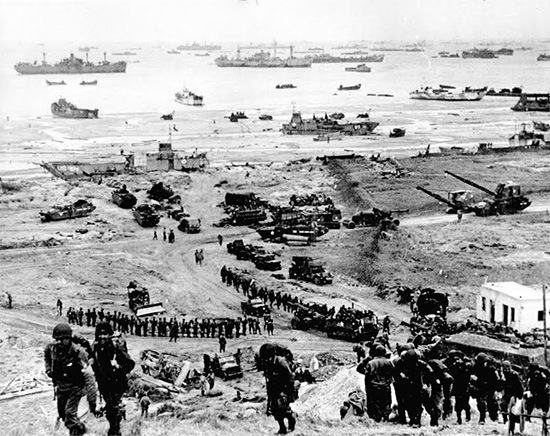
General view of Omaha Beach taken from the bluffs overlooking the beach and illustrating American troops moving inland. Photo probably taken a few days following D-Day, 6 June 1944.
Chronological Report of Activities:
14 May 1944 – 21 June 1944
On 14 May 1944, while the 51st Field Hospital was still in the midst of final detailed preparations at its home station, Ross-on-Wye, Herefordshire, the organization’s 18 Nurses were attached to and joined the 24th Evacuation Hospital at Cheddar, England, for the purpose of overseas transportation. On the same day, all hospital equipment (except that which could be loaded on organic unit vehicles) was moved to the port of Barry, in Wales. After considerable controversy 1 Officer was finally authorized to remain with the equipment constantly until delivery to the far shore. This seemingly unimportant concession proved valuable in assuring that all equipment would arrive complete and intact at the proper destination. Other units without similar supervision lost as much as 30% to 50% of their vital supplies and equipment.
Early on the morning of 16 May, on very short notice, all the organization’s vehicles with 6 Officers and 36 Enlisted Men left for the Concentration Area by motor convoy. The remaining 15 Officers and 148 EM departed later the same day by rail. A period of confusion began with the two above sections being sent from one wrong destination to another during three days without rations or cooking facilities. Everybody was finally re-assembled on 19 May 1944 in the Provisional Concentration Area camp in the vicinity of Andover, together with the 365th Engineer General Service Regiment (Colored).
US Army Hospitals – Ross-on-Wye, Herefordshire, United Kingdom
13th Field Hospital
51st Field Hospital
(Camp capacity > 1300 men)
On 5 June 1944, the organization moved to the Marshalling Area in Southampton, where it waited for its sailing orders, which came on 7 June.

Photo illustrating an Operation Room with surgery going on, probably taken around mid-June 1944, following opening of the 51st Field Hospital in Normandy, France, on 11 & 12 June 1944.
France:
Half of the organization’s vehicles, with 9 Officers and 51 EM sailed on an LCT, the other half of the vehicles with 8 Officers and 68 EM traveled aboard another LCT, while the remaining 3 Officers and 72 EM boarded an LCI. After an uneventful trip, the convoy arrived off the coast of Normandy the morning of 8 June. A number of fruitless attempts were made to land, but each time the landing crafts were signaled to stand off. Finally the order came to – land in spite of danger – and the Hospital came ashore in the Easy Green sector, Omaha Beach, at 1600 hours, 8 June 1944, with neither interferences nor casualties. Upon embarking, the only instructions were to assemble near Englesqueville. Since the unit’s Liaison Officer already ashore had, for some unaccountable reason, been ordered not to leave his bivouac area, there was no one to meet the organization on the beach. It was thus felt more prudent to check the situation first (Englesqueville was still in enemy hands –ed). A different Assembly Area was selected at the top of the hill behind Easy Green Beach, in the vicinity of the 393d Medical Clearing Company. Aside from a half-track being blown up by a mine, the move to this new assembly area was uneventful. For the following day there was not much to do but dig in, and take cover for the constant sniping and repeated air attacks at night. Aside to some damage to vehicles and equipment, no casualties were sustained.
On 9 June 1944, the ship with the organization’s equipment was located and with the help of Colonel Howard E. Snyder, FUSA Surgeon’s office, a high unloading priority was established. On 10 June, almost 100 tons of equipment and supplies were brought ashore by amphibious DUKWs. With the exception of one tent and a chest of unimportant mess equipment, everything arrived 100% complete. The Nurses complement would arrive off the French coast around 2300 hours, 11 June 1944, aboard the Liberty Ship “Francis Drake” (EC2-S-C1 hull launched 27 June 1942, delivered 8 August 1942 by the California Shipbuilding Corp., Wilmington; which built a total of 306 Liberty cargo and 30 Liberty tanker ships between 1941-1945 –ed).
The following days, all 3 Units would operate in the capacity of a modified Evacuation Hospital. The unit’s code name was “Meridian 51” (other Hospitals with a similar code were the 42d Fld Hosp – “Meridian 42” and the 47th Fld Hosp – “Meridian 47” –ed).
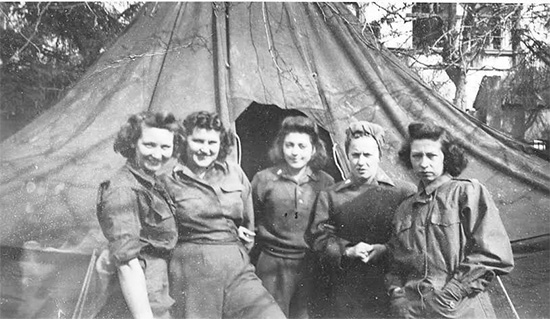
Group of Nurses in front of a M-1934 Fire-Resistant Pyramidal Tent. Maximum capacity of such a tent was 8 people when the pot-bellied stove was not in use. However for reasons of comfort and sanitation, it was recommended to limit the number of persons to 6 when supply of tentage was sufficient.
Locations & first Operations on the Continent – 51st Field Hospital Units
Landing on Omaha Beach, Normandy > 8 June 1944
Opening 1st Hospital Unit – 11 June 1944
Opening 2d Hospital Unit – 12 June 1944
Opening 3d Hospital Unit – 12 June 1944
1st Hospital Unit – on 11 June 1944, the 1st Unit set up adjacent to the 634th Medical Clearing Company, 60th Medical Battalion, 5th Engineer Special Brigade (landed between 1400-1500 hrs, D-Day –ed), partly way up the exit D-3 draw toward St.-Laurent and began to receive its first patients. 3d and 4th Auxiliary Surgical Group Teams initially provided surgical personnel. The following day the staff was supplemented by members of the surgical service belonging to the 24th Evacuation Hospital and the organization’s Nurses who had arrived together on 12 June (Principal Chief Nurse > Myrtle Reynolds –ed). Fifty percent of the Nurses went on duty that same night, while the rest slept and started duty the next morning at 0800. The front line was just four miles inland. A total of 214 patients were admitted in 5 days, with 143 receiving definitive surgery. On 18 June, the unit moved on opening at Cartigny-l’Epinay as a Field Hospital in support of the 29th Infantry Division Clearing Station. It was still in operation at this location by 22 June.
2d Hospital Unit – on 12 June 1944, the 2d Unit opened in the vicinity of La Poterie, about 5 miles deeper inland. A total of 121 patients were admitted in the first 36 hours, with 68 receiving definitive surgery. It then moved further and opened at Vouilly on 16 June as a Field Hospital in support of the 29th Infantry Division. Between 16 and 18 June, the Unit admitted and treated 89 seriously wounded non-transportable casualties with 10 deaths.
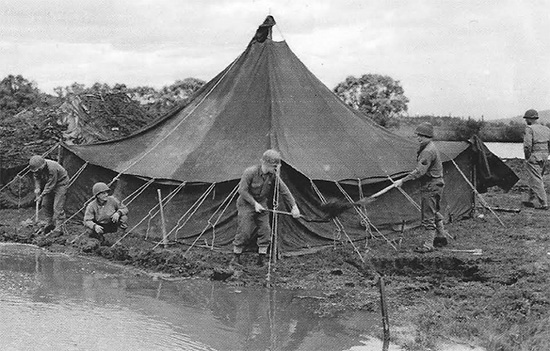
Rain and mud in fall and winter often hampered operations in the field as can be seen from this vintage photo.
3d Hospital Unit on 12 June 1944, the Unit opened for receiving in La Cambe, admitting a total of 303 patients in the first 48 hours, of which 145 received definitive surgery. On 17 June, the Unit traveled to Isigny, opening as a Field Hospital in support of the 30th Infantry Division Clearing Station.
The Hospital’s personnel gradually became used to the sound of aircraft, bombs, artillery fire, and the fighting not far away. The job was to get as close as possible to the front, in order to do the repair work on the many casualties, and send them on to the Evacuation Hospitals as soon as possible. ANC Officers were to work 12-hour shifts and handle about 50-man groups of patients. During that particular period the organization was given a new drug, still in the experimental stage, designated “penicillin”.
From 11 June 1944 to 22 June 1944, the 51st Field Hospital admitted, treated and discharged 837 patients.
Number of Admissions – 51st Field Hospital
586 Patients – week ending 16 June 1944
200 Patients – week ending 23 June 1944
76 Patients – week ending 30 June 1944
68 Patients – week ending 7 July 1944
316 Patients – week ending 14 July 1944
267 Patients – week ending 21 July 1944
198 Patients – week ending 28 July 1944
22 June 1944 – 31 August 1944
In its first operational phase, the 3 Units of the 51st Field Hospital gave indirect support to Infantry Division Clearing Stations, during the drive on and through the city of St.-Lô, a period in which the three Hospital Units worked as acting Evacuation Hospitals serving the entire VII Corps. Each Hospital Unit or Platoon could act independently and was capable of caring for 100 patients. In fact it was considered to be a kind of mobile type of Station Hospital, covering areas where fixed bed facilities were not present and construction was not feasible.
1st Hospital Unit – on 22 June 1944, the Unit continued to support the 29th Infantry Division during the intense and bloody hedgerow fighting and the drive for St.-Lô. The 3d Armored Division was added about 1 July. Evacuation during the period was excellent and the cooperation of the 104th Medical Battalion (29th Inf Div –ed) and the 45th Armored Medical Battalion (3d Armd Div –ed) were of the highest order. The only shortage at the time was whole blood, but this was largely overcome by forming a unit blood bank using volunteer donors from the service troops of the Divisions supported. Air and artillery activity were intense during the entire period, with limited property damage and no casualties. From 18 June to 16 July 1944 inclusive, the Unit admitted and treated 340 seriously wounded non-transportable patients, resulting in 48 deaths.
Between 30 July and 2 August 1944, the 1st Unit opened just east of St.-Lô in support of the 35th Infantry Division and the 2d Armored Division in their drive down the east bank of the Vire River. During this period, it admitted and treated 92 seriously wounded non-transportable patients with a total of 16 deaths.
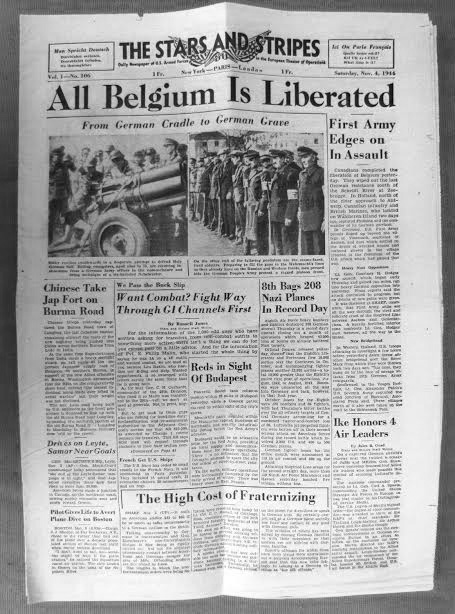
Vintage copy of The Stars and Stripes dated November 4, 1944, stating: All Belgium is Liberated.
On 5 August 1944, the 1st Hospital Unit suffered its first battle casualty when Tec 5 Eugene E. Trester, ASN 36817442, was killed by a mine explosion, when, without regard for his own safety, he entered a nearby minefield attempting to help remove a soldier who had been seriously wounded by another mine. He was posthumously awarded the Bronze Star Medal.
On 11 August, the organization replaced the 47th Field Hospital supporting the 30th Infantry Division and part of the 4th Infantry Division at La Chapelle-Urée. While at this location the unit handled part of the serious casualties arising from the desperate but unsuccessful German counter-attacks in an attempt to retake Avranches. From 11 August to 15 August inclusive, 30 seriously wounded were admitted and treated with a total of 9 deaths. The unit moved on to Saint-Cyr-du-Bailleul on 16 August in continued support of the 30th Infantry Division but closed on 19 August 1944, after admitting only 1 patient, in compliance with instructions to close and clear all Field Hospitals.
2d Hospital Unit – on 22 June 1944, the 2d Unit was inactive and in reserve with the 1st Hospital Unit in the vicinity of Cartigny-l’Epinay. Its personnel worked in the setup on regular shifts allowing shorter hours and less strain on personnel. On 11 July, the Unit opened at Lison in support of the 30th Infantry Division as well as the 3d Armored Division during their drive down the west bank of the Vire River. Casualties were severe and heavy. The Unit closed for admission on 19 July. During the period from 11 July to 19 July inclusive, 168 seriously wounded non-transportable patients were received and treated, with 21 deaths. The same day the 2d Hospital Unit opened simultaneously at Amy, continuing its support of the 30th Infantry Division. Between 19 July and 28 July 1944, 135 seriously wounded patients were admitted and treated, with 23 deaths. On 28 July, the Unit moved to a new site, opening near St.-Lô. Later casualties from both the 30th and the 28th Infantry Divisions were handled at this new location. On 3 August 1944, the Unit closed when the 28th Inf Div moved forward and the 30th Inf Div went into rest near Tessy-sur-Vire. From 28 July to 3 August 1944 inclusive, it treated 126 seriously wounded patients, of which 26 died. The 2d Unit was subdivided into 2 almost completely self-sustaining surgical sections, one remaining in operation (as a holding unit) at the old location, until the other safely set up and ready to open in the new location.
3d Hospital Unit – on 22 June 1944, the 3d Unit was still supporting the 30th Infantry Division near Isigny. Most of the heavy casualties resulted from the Division’s crossing of the Vire River, and the intensive 3,000-plane bombing attack preceding the American breakthrough west of the Vire. The mangling injuries and bomb blast syndrome cases arising from this operation were among the worst handled by the organization. The Unit closed its installation when the 30th Infantry Division Clearing Station moved to Lison. Supply and evacuation were excellent, as was the cooperation with the 105th Medical Battalion (30th Inf Div –ed). From 16 June up to 11 July 1944, the 3d Unit admitted and treated 246 seriously wounded patients, with 38 deaths. On 15 July, the Unit opened near St. Clair-sur-l’Elle in support of the 29th Infantry Division Clearing Station, and later on the casualties of the newly-arrived 35th Infantry Division. Several patients in the adjacent Clearing Station Admission tent were wounded and one 104th Medical Battalion ambulance was hit by an artillery shell. An appreciable number of severe bomb casualties were treated at this location also. From 15 July to 29 July 1944, the Unit admitted and treated 205 seriously wounded patients, with 39 deaths. On 29 July, it opened south of St.-Lô at Torigni-sur-Vire simultaneously with its closing at St. Clair. The Unit ceased operations 5 August 1944 when all Field Hospitals were ordered inactive. During a 5-day period, the shortage of whole blood continued and therapeutic oxygen was unobtainable for the first time. From 29 July to 5 August 1994, the 3d Hospital Unit admitted and treated 88 seriously wounded patients, and had to cope with 21 deaths.

Hospital units often used discarded German ammo boxes for carrying and protecting medical supplies. They had to improvise as sufficient material was not always available, considering the long haul for supply when the rapid advance of combat elements made it difficult for Hospitals to closely follow the Divisions they were medically supporting.
During the period described, the 51st Field Hospital provided close medical and surgical support to the many Infantry Division Clearing Stations of the troops driving on and fighting through St.-Lô. It only handled and treated the seriously wounded non-transportable cases, with the less serious being bypassed to Evacuation Hospitals in the rear. On several occasions the organization was supporting up to four Infantry Divisions simultaneously. During the past period, the three Hospital Units admitted and treated a total of 1,419 seriously wounded patients, with 241 deaths.
On 15 August, the organization, like the other First United States Army Field Hospitals, was attached to the 68th Medical Group under Colonel Francis P. Kintz, MC (now responsible for evacuation of Division and Corps Clearing Stations and Field Hospitals across the entire Army front –ed). From 16 August to 25 August 1944, the entire 51st Field Hospital moved eastward across France with a number of successive bivouac stops at St. Hilaire, Couterne, and finally Senonches (regrouping of medical units after the Falaise encirclement to an area around Senonches –ed). After a 2-day re-organization period in the Medical Concentration Area (Senonches, grouping 5 Field Hospitals –ed), a new operational phase began. Since the entire organization was now to function as a modified Evacuation Hospital, appreciable changes in the use of personnel and the physical layout were necessary. The plan, in essence, was for the 1st and 2d Hospital Units to alternate with one another at successive moves forward (leapfrogging –ed). At each new setup, the organization Headquarters and the 3d Hospital Unit in a supplementary capacity were sent forward immediately. This allowed ready availability and full use of personnel and equipment of two Hospital Units forward to meet any possible emergency demands. Functionally, it divided the organization into 2 very flexible sections – an active forward one with 2 Hospital Units and an inactive rear section with one Hospital Unit closing out. To handle the increased volume of surgery brought about by the definitive treatment of lightly wounded patients, 10 completely equipped operating tables were maintained in the forward section 24 hours per day. All attached Surgical Teams and Nurses in the forward section made immediate surgery available without undue strain on personnel. The CO of the 3d Hospital Unit functioned as the Executive Officer and Second-in-Command. This system allowed for unified control and coordination of both forward and rear sections. The Commanding Officer in charge of the overall organization remained, Lt. Colonel Harry P. Harper, MC.
On 27 August 1944, the new organization opened a modified Evacuation Hospital southeast of Paris at Réau supporting the entire VII Corps and thus became the first FUSA Hospital to set up east of the Seine River. On 29 August, without interrupting the flow of incoming patients, the organization opened at a new location near the Marne River at Signy-Signets. This was accomplished by receiving patients at the rear section until the new forward section was ready to open. At both locations there was considerable difficulty with evacuation to the rear due to inadequate bridges across the Seine and partially because of the considerable distances back to other Army and ComZ medical units. In a number of instances, cases had to be operated upon because no ambulances were available for evacuation. At Signy-Signets, supply was adequate but required daily long hauls, and the 57th Medical Battalion and the 51st Field Hospital first joined to form a more practical and cooperative working combination.

Winter scene. Recovered bodies of dead enemy soldiers are evacuated to the rear in American WC-54 3/4-ton ambulances. Photo taken 26 January 1945 in Germany.
Between 27 August and 31 August 1944, the organization admitted 688 patients, of whom 141 were diseased, and 547 wounded or injured. About 40% of all admissions were either PWs or civilians. Only non-transportable PWs and civilians were operated upon.
1 September 1944 – 30 September 1944
On 1 September 1944, after having been in operation 3 days as a modified Evacuation Hospital in support of VII Corps at Signy-Signets, the 51st Field Hospital reopened at a new location some 100 miles farther forward. In this move it became the first US Army Hospital to cross the Marne and Aisne Rivers in World War Two when it opened 10 miles east of Laon, near the town of Saint-Erme. The 67th Evacuation Hospital which had set up in the vicinity of the old location at Signy-Signets took over all remaining non-transportable cases. Evacuation was meanwhile improved considerably by the addition of 20 ¾-ton ambulances received from the 31st Medical Group.
A total of 288 patients were admitted during the organization’s stay at Signy-Signets, among which 24 slightly wounded and 174 seriously wounded. About 75% received definitive surgery. At Saint-Erme, the Hospital handled the casualties arising from the fighting around the pocket of Mons, Belgium. American casualties remained moderate and only reached a peak of 152 on 4 September 1944. German losses were increasingly heavy between 2 and 5 September. On this same day, enemy casualties reached such a peak that it was decided to bypass them direct to ComZ units. Only 63 enemy wounded were officially admitted for treatment out of 450 received at the Hospital. The rest were re-dressed, fed, and evacuated as quickly as transportation would allow. To help relieve the overtaxed ambulances, a returning convoy of 5 empty 2 ½-ton cargo trucks was pressed into service in this evacuation. During their stay at Saint-Erme the organization received a total of 674 patients, among which 232 very seriously wounded German PWs. Tents were full to overflowing and fortunately thanks to the mild weather, rows of waiting patients on stretchers were lined up on the ground outside the ward tents, as Surgeons worked 24 hours a day, without taking a rest. Finally a large Station Hospital moved in to relieve the 51st.
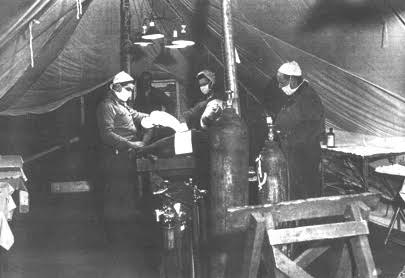
Partial view of Operation Room of the 51st Field Hospital when established at Les Annais, Belgium, January-February 1945.
Belgium:
Following the capture of Brussels, Belgium by the British (liberated 4 September 1944 –ed), VII Corps took a sharp turn to the east. On 5 September 1944, the 51st became the first US Army Hospital to enter and set up in Belgium. It opened the same day 8 miles south of Philippeville, in the town of Mariembourg where it remained until 9 September. During this period there were 836 admissions of which 714 were surgical cases. Many of the 229 German PW patients were evacuated to Paris in the Hospital’s own scanty trucks. On 10 September, the entire Hospital moved to a temporary bivouac area 14 miles southeast of Liège, near Villers-le-Temple, Belgium. This day marked the only interruption in the organization’s continuous medical support of VII Corps in its long sweep across France and Belgium to Germany. The following day, the Hospital again opened in support of VII Corps northwest of Dison (Verviers region) in Petit-Rechain. Friendly locals often visited to watch the Hospital’s staff and personnel at work, and many townspeople invited members of the organization into their homes. In anticipation of a further rapid advance, the location was initially next to the 3d Armored Division Treatment Station and ahead of the Infantry’s Clearing Stations. This proved one of the heaviest stands in the 51st Field Hospital’s history. Ten (10) operating tables were kept running 24 hours a day. After closing 16 September, a total of 1,004 patients had been admitted in only 86 hours! Of this number 786 were surgical and definitive surgery was performed on 531.
This closed the operational phase in which the 51st Field Hospital operated as a modified Evacuation Hospital. Between 27 August and 16 September 1944, the unit admitted 3,549 patients, of which 1,820 received definitive surgery. On 17 September, the Hospital reverted to its old status and resumed the function of a normal Field Hospital when the 1st Hospital Unit took over surgical support of the 9th Infantry Division Clearing Station. On this day the unit became the first Hospital to set up on German soil when it opened at Roetgen, Germany. At the close of the month, the Unit was still active at the same location. A total of 120 seriously wounded non-transportable patients was received and treated, with 29 deaths registered. This group included some of the worst casualties encountered by the surgical staff. The 2d and 3d Hospital Units remained in reserve in bivouac until the end of September.
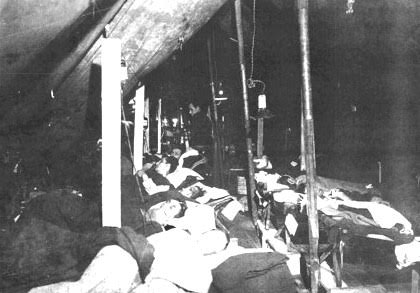
Partial view of Patients Ward of the 51st Field Hospital when set up at Les Annais, Belgium, early February 1945.
Germany:
1 October 1944 – 31 October 1944
1st Hospital Unit – on 1 October 1944, the Unit still in uninterrupted support of the 9th Infantry Division Clearing Station, moved from their setup under tentage into a school building at Roetgen, Germany, because of mud and untenable weather conditions. As it had been raining for days, the weather had turned cold and the fields particularly muddy. It was even slippery inside the tents. Someone then found a vacant school building, so a part of the unit moved indoors for the first time. There was electricity, lighting, heat and wooden floors and class rooms made excellent wards. The school cafeteria was turned into a mess. A house next door became the Nurses’ quarters. Although casualties were relatively few, the organization remained open throughout the month and received a constant dribble of patients. It admitted 223 serious wounded, with 56 deaths. Fatigue, bad weather, and low vitality among the troops supported were shown by an increase in mortality as well as by their poor response to shock therapy. On 2 October 1944, all of the organization’s original ANC staff who landed on Omaha Beach were still 2d Lieutenants; they received their battlefield promotions to 1st Lieutenant in recognition of their outstanding performance.
2d Hospital Unit + 3d Hospital Unit – on 12 October 1944, the remainder of the 51st Field Hospital moved from Petit-Rechain to Roetgen in Germany, in bivouac. Officers, Nurses, and Enlisted Technicians of the 2 inactive Units worked in the 1st Hospital Unit in an augmenting and relief capacity. While set up at Roetgen, the Hospital’s location was right in the path of German V-1 and V-2 rockets, Germany’s secret weapons.
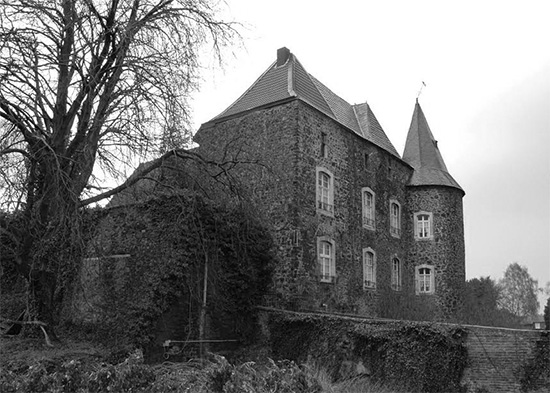
Roetgen Castle, Germany. Photo taken in October 1944. During this time the entire 51st Field Hospital was established in Roetgen, where they were housed in buildings.
1 November 1944 – 30 November 1944
1st Hospital Unit – on 1 November 1944, the 1st Unit was still operating in the school building at Roetgen, Germany. It remained open throughout the entire month handling in turn the non-transportable casualties of the 4th, 8th, and the 28th Infantry Divisions, and the 5th Armored Division. A total of 354 seriously wounded patients were admitted for treatment, with 689 deaths. 296 operations were performed with 56 post-operative deaths.
2d Hospital + 3d Hospital Unit – the two other Hospital Units remained in bivouac with the personnel helping the 1st Hospital Unit whenever necessary.
Between 15 – 18 November, the personnel received a welcome break, and many were given a pass to Malmédy, Belgium, a FUSA Rest Area.
1 December 1944 – 31 December 1944
1st Hospital Unit – on 1 December 1944, the Unit closed to admissions transferring its remaining 35 patients to the 2d Hospital Unit, 45th Field Hospital, which took over surgical support of the sector for administrative reasons. Between 2 and 4 December, the 1st Unit moved into bivouac just south of Aachen, Germany. This was Eschweiler, some 9 miles east of Aachen. The Nurses were billeted in a large private home, the male Officers lived in another home, and the Enlisted Men were housed in a castle. Since tactical developments in the sector allowed, the length of the bivouac period was prolonged considerably.
Following the German counter-offensive breakthrough in the Bulge (Belgium, 16 December 1944 –ed), the 51st moved back to Huy, Belgium, by truck shuttle on 26 December. Here, the unit was established in a Belgian Military Post formerly occupied by the 4th Convalescent Hospital and opened in the capacity of an Evacuation Hospital on 27 December 1944. At this new location, casualties from VII Corps were handled on a 50-50 basis with the 102d Evacuation Hospital. During the 5-day period lasting from 27 December to 31 December 1944 inclusive, the Field Hospital admitted and cared for 417 patients including: 97 severely wounded in action – 83 lightly wounded in action – 63 non-battle injured – 23 neuro-psychiatric patients – and 151 diseased and other cases. Total admissions for December amounted to 421, of which 125 received definitive surgery, with 4 deaths being registered. No difficulties were encountered in the evacuation of patients and no unusual supply problems were however experienced by the Hospital.
2d Hospital Unit + 3d Hospital Unit – between 2 and 4 December 1944, both Units moved into bivouac at Eschweiler, Germany. Considering the current tactical developments they remained in bivouac for quite some period.
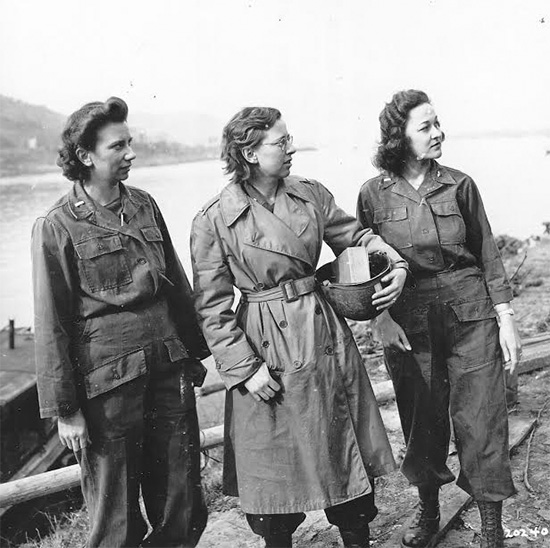
Group of ANC Officers pertaining to the 3d Hospitalization Unit, 51st Field Hospital. Photo taken on 24 March 1945 at Honnef, Germany.
1 January 1945 – 31 January 1945
Beginning January 1945, the 51st Field Hospital was still in operation at Huy, Belgium. Between 1 January and 10 January 1945 at total of 1,523 patients were admitted and treated, with a total of 18 deaths. On 10 January, the 49 remaining patients were transferred to the 67th Evacuation Hospital which took over the same buildings occupied by the organization. Among the different cases treated there were: 505 severely wounded in action – 411 lightly wounded in action – 87 non-battle injured – 1 neuro-psychiatric patient – 419 diseased and other cases.
On 2 January, an inspection was made by Colonel Francis P. Kintz, Commanding Officer, 68th Medical Group, who presented Bronze Star Medals to 11 members of the unit on 3 January; 2 Officers, 3 Nurses, and 5 Enlisted Men received the BSM for meritorious service and 1 Nurse for heroic achievement.
Between 8 and 11 January 1945, the entire Hospital moved to the vicinity of Villers-Ste-Gertrude, Belgium.
1st Hospital Unit – on 8 January, 1945 the Unit went into bivouac. After 22 January it moved from bivouac to Lierneux, opening in a building formerly used as a home for insane people. The unit remained in operation for the remainder of the month without encountering any serious problems.
2d Hospital Unit – on 12 January 1945, the 2d Unit opened for admissions near Les Annais, Belgium as a Surgical Hospital, housed in semi-winterized tents as buildings were not available. This was necessary due to the long distance between the Clearing station and the Evacuation Hospital.
3d Hospital Unit – between 8 and 11 January 1945 the 3d Unit went into bivouac, together with the 1st Hospital Unit.
1 February 1945 – 28 February 1945
Between 4 February and 10 February 1945, the entire 51st moved to Eschweiler, Germany. Casualties handled at both Eschweiler and Düren were particularly serious, and most patients were suffering from wounds caused by HE shell fragments. Over 25% of all cases had multiple serious wounds. During the period described in the report, 137 serious cases were treated and 2 non-battle injuries.

Group of Nurses of the 51st Field Hospital, first ANC personnel to have crossed the Rhine River. Photo taken 14 March 1945.
1st Hospital Unit – the Unit was closed to admissions at its location near Lierneux, Belgium, with no patients remaining. Between 4 and 10 February the 1st Unit went into bivouac near Eschweiler, Germany.
2d Hospital Unit – on 1 February 1945, the Unit closed its operations near Les Annais, Belgium, with a total of 3 seriously wounded non-transportable patients remaining. On 26 February, a few days after the Roer River crossing, the Unit opened for receiving at Düren, Germany in support of the 3d Armored Division Treatment Station and the 8th and 104th Infantry Division Clearing Stations.
3d Hospital Unit – on 11 February 1945, the 3d Unit opened in the same buildings it had occupied in Eschweiler in December 1944. Functioning as a Surgical Hospital it now supported the 3d Armored, the 8th Infantry, and the 104th Infantry Divisions. It closed on 26 February after admitting and treating 86 wounded, with a total of 11 deaths.
1 March 1945 – 31 March 1945
During the month of March, Headquarters, 51st Field Hospital moved six times, always attempting to stay with the forward unit. Following cases were admitted during March 1945: 605 severely wounded in action – 47 lightly wounded in action – 64 non-battle injured – 5 neuro-psychiatric patients – 30 diseased and other cases – and 94 deaths.
1st Hospital Unit – on 4 March 1945, the 1st Unit opened as a Surgical Hospital in Bergheim, Germany where it occupied a high school building together with the 3d Armored Division Treatment Station after crossing the Erft Canal with one of Combat Commands rather early during the armored drive on Cologne (4 Rhine bridges were still intact, at Cologne, Bonn, Engers and Remagen –ed). Casualties from the 3d Armored Division, the 4th Cavalry Group, and the 99th Infantry Division were treated at this location. The Unit closed 7 March turning over the 39 last remaining patients to the 103d Evacuation Hospital which relieved it. A total of 57 serious cases were admitted and treated, with 10 deaths. On 9 March, after another move, it opened in support of the same three combat units in Skt. Elisabeth Krankenhaus, Cologne, Germany. As there was no tactical activity in the sector when the Unit closed 20 March, only 20 seriously wounded non-transportable patients were received, with 4 deaths.
2d Hospital Unit – on 1 March 1945, the Unit was still functioning at Düren. It closed at its location on 5 March, after having admitted and treated 91 seriously wounded patients, with 15 deaths.
On 13 March, at very short notice, the 2d Hospital Unit became the first US Army Field Hospital to set up east of the Rhine River, when it crossed the Remagen bridge (on a pontoon bridge) to Unkel, only six days after the initial assault crossing. The very first Nurses to cross included Lois K. Grant, Ione C. Kinnick, Helen D. Johnson, Madalyn H. Andreko, Josephine J. Jennis, Bertha B. Wachter, Mildred A. Judkins, Kay Watry, Florence R. Bestman, Frances M. Anderson, and Dorothy V. Judd. Although having to dodge some enemy strafing on their way to the bridge, nobody was hurt. It had been moving in the direction of Remagen and following other Army units seized the opportunity to cross and back up the eastward line of advance. At the time many Rhine bridges had been destroyed by the retreating enemy. Air activity was intense in the sector, and 3 of the Unit’s personnel were slightly wounded during the crossing. Being the only Hospital in support of 1st Armored and 4th Infantry Divisions resulted in a fairly busy operation. When the 2d Unit closed 20 March, it had treated 211 wounded, with 27 deaths, serving as an Evacuation Hospital (the units also served as Holding Hospitals at airstrips or Station Hospitals for the care of non-combatants –ed). The Unit was subsequently freed from further active field service when the remaining non-transportable patients were taken over by the 47th Field Hospital on 24 March 1945. Because heavy bridge traffic across the river delayed ambulance evacuation considerably, many patients were evacuated by L-1 light evacuation planes. An attempt to arrange for glider pick up was aborted in spite of the success of the two experimental glider trips completed previously.
When the encirclement swung abruptly north at Herborn, the Unit made a 75-mile move on 31 March and opened as a Surgical Hospital in support of the 3d Armored and 104th Infantry Divisions at Korbach, Germany.
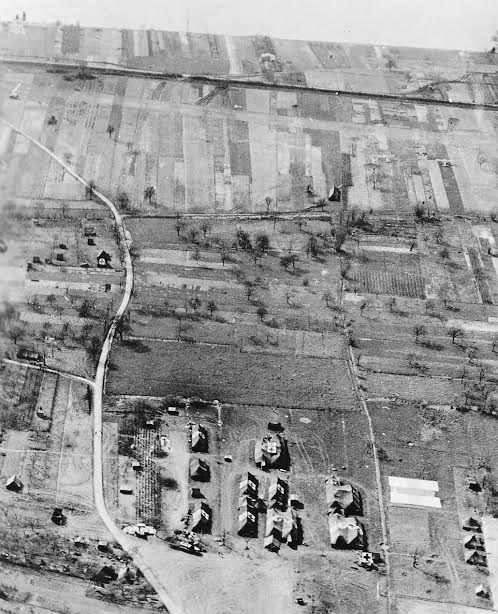
Partial aerial view of the 51st Field Hospital, while established in Germany.
3d Hospital Unit – on 7 March 1945, the 3d Unit opened at Horrem, Germany in support of the same three units in their final assault on Cologne. It was established at the famous Burg Hemmersbach, castle of Wolfgang, Graf Berghe von Trips, where it closed 11 March after admitting and treating only 11 seriously wounded and non-transportable patients. On 20 March, it re-opened at another site in close support of the 3d Armored, 1st Infantry, 78th Infantry, and 104th Infantry Divisions. On 24 March the Unit stopped operations at Honnef, after transferring its last cases to the 45th Evacuation Hospital. A total of 82 patients were admitted and treated, with 13 deaths. On 27 March, the men were on the move once more opening at Sauerweise, Germany. As soon as it was replaced by the 44th Evacuation Hospital, the Unit closed on 28 March, after admitting another 21 seriously wounded, with 2 deaths.
1 April 1945 – 30 April 1945
From 19 April to 30 April 1945, the 51st Field Hospital remained in bivouac at Halle, Germany, and was able to reorganize all equipment and vehicles for further operations. The following types of cases were admitted and treated by the organization: 314 military and 410 civilian (mostly DPs). Total admissions numbered 724, with 86 deaths.
1st Hospital Unit – on 1 April 1945, the Unit was still open operating as an Evacuation Hospital at Herborn, Germany. Most of the casualties received came from the Ruhr Pocket encirclement. On 5 April, with very short notice, the 1st Unit made a difficult night move in the rain to set up the following morning in support of III Corps in its westward drive to reduce the pocket. The patients remaining at Herborn were taken over by a Holding Unit pertaining to the 47th Field Hospital. In the following 8 days the organization treated 88 seriously wounded patients, with only 1 death.
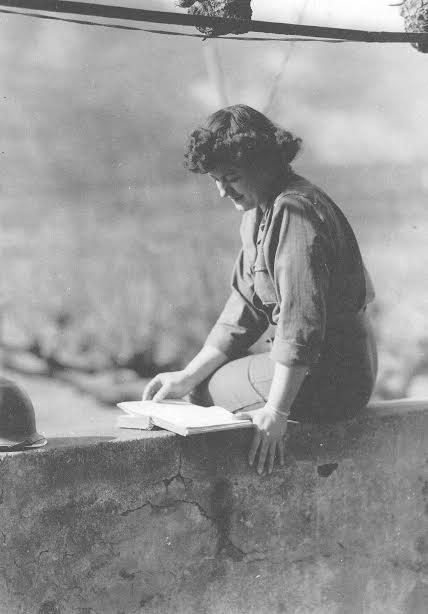
Photo of 2d Lieutenant I. C. Kinnick, ANC, taken on 15 March 1945 at Unkel. After crossing the Rhine River on a pontoon bridge at Remagen, the 2d Hospitalization Unit, 51st Field Hospital moved to Unkel, Germany, on 13 March 1945.
2d Hospital Unit – on 1 April 1945, the 2d Unit was still open for receiving as a Surgical Hospital 70 miles further forward at Korbach, Germany. Most of the casualties resulted from the south prong of the severe fighting in the Ruhr Pocket. Together the 1st and 2d Hospital Units treated 331 patients, 254 of whom were seriously wounded.
As VII Corps now approached its tactical stop line, the Unit set up in the vicinity of Halle on 16 April. This move proved to be the last tactical set up by the 51st Field Hospital for the current operational phase. Four days later, the Unit closed when relieved by the 98th Evacuation Hospital after admitting and treating 19 wounded, with a single death.
3d Hospital Unit – on 12 April 1945, the day Nordhausen, Germany, was captured by the 3d Armored and the 104th Infantry Division, the 3d Hospital Unit opened there initially as a Surgical Hospital. As an emergency measure, however, it became necessary to admit large numbers of severely diseased former inmates of the Dora-Mittelbau Concentration Camp as well as the usual surgical cases. In only 5 days 86 serious cases were admitted with 42 deaths. Dysentery was a major problem as American medical personnel attempted to feed the liberated prisoners. During this period of time, the unit’s personnel heard the news that FDR had died.
1 May 1945 – 31 May 1945
On 1 May 1945, the entire 51st Field Hospital was established at Halle, Germany. Between 11 June 1944 and 8 May 1945, the Hospital handled a total of 9,763 casualties with a total of 786 deaths. The organization performed 5,407 surgical operations, with 457 post-operative deaths.
1st Hospital Unit – on 1 May 1945, the 1st Unit was in bivouac with the entire Hospital at Halle in Germany. On 4 May, the Unit opened to receive patients as a Field Hospital in Leipzig, Germany. At the time it supported VII Corps (receiving casualties from the 69th and 104th Infantry Divisions) which was making its final push to the Elbe and effecting a link-up with the Soviet Armies. At the cessation of hostilities, 8 May 1945, the organization was still open for receiving, and shortly thereafter began functioning as a provisional Station Hospital. Between 1 and 8 May it treated 107 patients, with 1 death.
During the month of May, the following types of cases were admitted and treated by the Unit: 622 military (with 5 deaths) and 628 civilian (with 5 deaths).
2d Hospital Unit – on 1 May 1945, the Unit was bivouacked on the Luftwaffe airfield at Halle, Germany, where it remained up to 15 May. It was closed between 1 – 8 May. The 2d Unit subsequently moved on to Bad Frankenhausen, Germany, to set up in the capacity of Station Hospital supporting all troops in the VII Corps area. Because of the lack of sufficient suitable buildings, it was necessary to house everyone in tents. On 4 July, the Soviets took over Bad Frankenhausen and the organization had to move to Salzboden. A rear detail remained behind for three days to take care of 4 non-transportable cases, and then joined the main body at the new location. The following cases were received and treated: 150 military and 2 civilian.
3d Hospital Unit – from 24 April to 15 May 1945, the Unit was also in bivouac at Halle, Germany, with a temporary closing from 1 to 8 May 1945. From 16 May up to 19 May it moved to set up at Kassel, Germany, where it functioned as a Station Hospital. Only 21 patients were received during this period. From 20 May the 3d Unit was once more on the move to another location at Heiligenstadt, where it remained until 5 July 1945. A total of 108 patients were admitted for treatment.
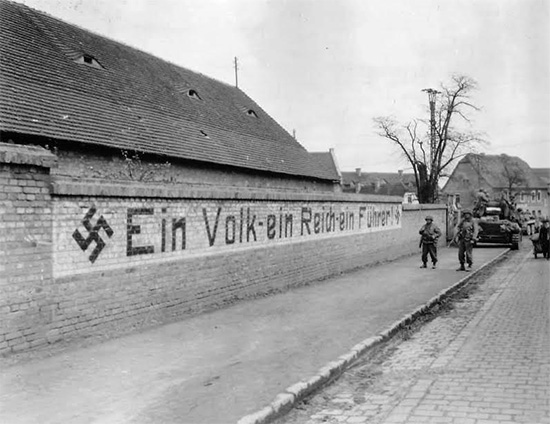
Troops of the 104th Infantry Division (Timberwolves) enter Halle, Germany, which they captured after a five-day struggle lasting from 15 to 19 April 1945. The entire 51st Field Hospital set up at Halle starting 19 April and remained in bivouac on site until 30 April 1945.
1 June 1945 – 30 June 1945
1st Hospital Unit – on 1 June, the Unit was still operating at Leipzig, Germany, where it was housed in buildings. During this period VII Corps was relieved by XXIII Corps and the 1st Unit now received patients from these troops. It also received many civilian patients who had been political prisoners of the Germans and were being returned to the American Zone from the Russian-occupied sector. The following cases were received for treatment during June: 503 military (with 2 deaths) and 537 civilian (with 2 deaths).
2d Hospital Unit – from 1 June up to 3 June 1945, the following patients were admitted and treated at the Unit: 310 military and 1 civilian. Because of the lack of suitable sized buildings, the installation had to set up in tents.
3d Hospital Unit – from 20 May to 5 July 1945, the organization remained in operation at Heiligenstadt, in some requisitioned buildings.
1 July 1945 – 31 July 1945
In July 1945, all three Hospital Units of the 51st were operating as Station Hospitals in the same location as at the close of 30 June 1945. The 1st at Leipzig, the 2d at Bad Frankenhausen and the 3d at Heiligenstadt, all in Germany. They were all supporting VII Corps field units. Early July brought some confusion as the Hospital now came under control of TUSA, which ordered all units to proceed to a bivouac area at Salzbaden, Germany, where they remained until 13 July. Redeployment was delayed and movement didn’t start until 19 August 1945.
1st Hospital Unit – on 2 July 1945, at 0100 hours exactly, the Unit closed at Leipzig, Germany, and on this date the 41 remaining patients were discharged from the Hospital. This move was necessary because the Soviet Occupation Forces were moving into the city. It first bivouacked at Heiligenstadt before moving on to Salzbaden the next bivouac area. On 14 July, the Unit closed at Salzbaden and moved further to Weiden to act as medical support for the 90th Infantry Division. During the month of July the following cases were admitted and treated: 41 military and no civilian, with no deaths.
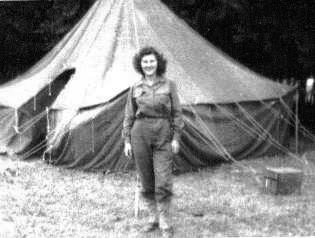
Photo of 1st Lieutenant Ruth M. Haddick, serving with the 2d Hospitalization Unit, 51st Field Hospital in front of a M-1934 Pyramidal Tent.
2d Hospital Unit – on 4 July 1945, the Soviets took over Bad Frankenhausen and the organization had to move to Salzbaden. A rear detail remained behind for three days to take care of 4 non-transportable cases, and then joined the main body at the new location. On 17 July, Headquarters and the 2d Unit moved to Coburg, Germany to establish a Station Hospital under XV Corps, and in support of the 9th Armored Division. The following types of cases were treated by the Unit: 29 military and no civilian.
3d Hospital Unit – from 6 July to 17 July 1945, the 3d Unit was in bivouac at Giessen, Germany. Between 18 July and 31 August 1945, the Unit was set up at Hof, Germany, where it operated in the capacity of a Station Hospital. Patients received numbered 51.
1 October 1945 – 31 December 1945
All Hospital Units were ordered closed on 5 October 1945. Redeployment of personnel was conducted both by XV Corps and Third United States Army, with high-point personnel going out on quota and to Category IV units.
On 10 October, the final Redeployment and Readjustment was carried out by the Surgeon, TUSA, and all personnel were transferred to other units. 4 Officers and 6 Enlisted Men went to the 67th Evacuation Hospital on 21 October 1945 to await final disposition.
By 1 November 1945, personnel had been reduced to just 1 Officer and 2 Enlisted Men. On 5 November, Lt. Colonel Orval T. Needels, MC, Commanding Officer 51st Field Hospital, was placed on TD with the 250th Station Hospital for an indefinite number of days while 1st Lieutenant Dave C. Clark was attached for TD from the 67th Evac Hosp. On 16 November, Lt. Colonel O. T. Needels was relieved from temporary duty with the 250th Sta Hosp and assigned to Headquarters, 80th Infantry Division. This left the 51st with a total of 1 attached Officer and 2 EM. On 19 November 1st Lieutenant D. C. Clark was also relieved from duty. Hospital Headquarters moved from Erlangen, to Ingolstadt, Germany, and were relieved from attachment to the 67th Evacuation Hospital and now attached to the 28th Field Hospital for quarters and rations. On 21 November, 2 assigned Officers; Captain David S. Carroll and Captain Leo A. Satz joined the organization from the 115th Station Hospital.
On 22 November 1945, Captain D. S. Carroll, MC, assumed temporary command of the Hospital, as per Paragraph 1, General Order # 15, Headquarters, 51st Field Hospital.
On 23 November 1945, Lt. Colonel David W. Clotfelter, MC, was assigned and joined from the 28th Field Hospital taking over command. On the same day, 3 MAC Officers joined the Hospital along with a group of 72 EM. After some reorganization and more transfers, the total number of personnel now reached 6 Officers and 72 Enlisted Men. On 25 November, 8 more Officers joined the 51st; 1 Major (MC), 2 Captains (DC), 1 Captain (MAC), and 4 1st Lieutenants (MAC). The next day, 5 Officers arrived with 26 EM, including 1 Captain (ChC) and 4 1st Lieutenants (MAC), increasing total strength to 19 Officers and 98 Enlisted.
On 27 November, 1 Captain (MAC) and 79 additional men joined the organization. On 29 November there was another increase in personnel with total numbers reaching 20 Officers and 210 EM.
On 30 November, Lt. Colonel D. W. Clotfelter was released from assignment, and left for the 14th Field Hospital. He was replaced by a new CO, Major Freeman D. Love, MC.
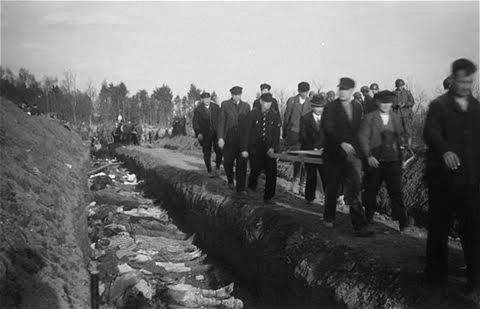
Vintage photo illustrating burial of Dora-Nordhausen Concentration Camp victims after the Camp’s liberation 13-14 April 1945. German civilian and military authorities were compelled to help with recovery and burial operations and forced to pass by the mass graves to witness the horrible and tragic death of the many inmates by the Concentration Camp authorities. The 3d Hospitalization Unit, 51st Field Hospital, set up a temporary Surgical Hospital in the Camp between 12-17 April 1945 to help alleviate the suffering and offer treatment and care to the survivors.
France:
On 30 November an advance party consisting of 1 Officer and 1 Enlisted Man left for Camp “Philadelphia”, France. On 1 December 1945, the main body of the 51st Field Hospital departed by rail for Camp “Philadelphia” in France, leaving Ingolstadt at 0930 hours, and arriving at the camp on 3 December 1945, at 1200 hours.
On 7 December, 1 Major (MC) and 2 Captains (MC) were transferred to Camp “Philip Morris”. On 9 December, 1 Captain (DC) and 1 EM were transferred, leaving total personnel strength at 15 Officers and 209 Enlisted Men.
On 9 December 1945, Captain Eugene D. Iden, DC, assumed command of the 51st Field Hospital. More people were transferred and a few men joined the organization during December. On 13 December, 39 Enlisted personnel were assigned to the Hospital, making a total of 246 EM.
On 20 December, the unit departed from Camp “Philadelphia” and moved to Camp “Pittsburgh”, France. During their stay, 1 Captain (MAC) left the organization, and 38 EM joined. Total strength was now 14 Officers and 285 Enlisted Men.
On 31 December 1945 the 51st Field Hospital left Camp “Pittsburgh” (one of the numerous City Camps near Reims, France –ed) by rail at 0800 hours and arrived at its new location, Camp “Herbert Tareyton”, France (one of the Cigarette Camps around Le Havre, France –ed). On 1 January 1946, transfer of more Enlisted personnel left the organization’s total strength at 14 Officers and 282 Enlisted Men.
Personnel Roster – 51st Field Hospital (25 December 1944)
Officers
| Lieutenant Colonel Harry P. Harper, MC (CO) | Captain William R. Schillinger, ChC |
| Major Gordon H. Bobbett, MC | Captain Thomas B. Smith, MC |
| Major Wilford C. Lacock, MC | Captain Irwin I. Spritzer, MC |
| Major Robey T. Sinclair, Jr., MC | Captain Baxter S. Troutman, MC |
| Captain Stephen M. Clement, MC | Captain Michael J. Tytko, MC |
| Captain Leo N. Goldin, DC | First Lieutenant Donald J. Croke, MAC |
| Captain Bernard Hanover, MC | First Lieutenant Junius C. Fox, Jr., MC |
| Captain Eric C. Loth, MC | First Lieutenant Charles A. Hix, MAC |
| Captain Elmer H. Miller, MC | First Lieutenant Archie Korngut, MAC |
| Captain Anthony F. Palmeri, MC | First Lieutenant Price O. Reinert, MAC |
| Captain Lawrence A. Pion, DC | First Lieutenant H.G. Williams, ChC |
| Second Lieutenant Guy S. Riherd, MAC |
Nurses
| First Lieutenant Madalyn H. Andreko, ANC | First Lieutenant Josephine J. Jennis, ANC |
| First Lieutenant Lois K. Grant, ANC (Chief Nurse) | First Lieutenant Dorothy V. Judd, ANC |
| First Lieutenant Carmen C. Di Marco, ANC | First Lieutenant Joy M. Lillie, ANC |
| First Lieutenant Janice T. Goers, ANC | First Lieutenant Katherine E. Lunger, ANC |
| First Lieutenant Margaret Grant, ANC | First Lieutenant Elizabeth Runyan, ANC |
| First Lieutenant Ruth W. Gray, ANC | First Lieutenant Marie J.Showalter, ANC |
| First Lieutenant Ruth M. Haddick, ANC | First Lieutenant Margaret J. Uhler, ANC |
| First Lieutenant Mary L. Jeffries, ANC | First Lieutenant Bertha B. Wachter, ANC |
| Second Lieutenant Dawn K. Alpin, ANC | First Lieutenant Beatrice I. Weigle, ANC |
| Second Lieutenant Frances M. Anderson, ANC | Second Lieutenant Ann Mervoy, ANC |
| Second Lieutenant Dorothy E. Budil, ANC | Second Lieutenant Mildred H. Overstreet, ANC |
| Second Lieutenant Mildred A. Judkins, ANC | Second Lieutenant Myrtle T. Reynolds, ANC |
| Second Lieutenant Ione C. Kinnick, ANC | Second Lieutenant Kay Watry, ANC |
Attached Nurses 3d Auxiliary Surgical Group
| First Lieutenant Eleanor E. Bernick, ANC | First Lieutenant Edna M. Parker, ANC |
| First Lieutenant Florence R. Bestman,ANC | First Lieutenant Velma E. Pierce, ANC |
| First Lieutenant Dorothy M. Dietrich, ANC | First Lieutenant Betty G. Ryan, ANC |
| First Lieutenant Betty E. Ferber, ANC | First Lieutenant Gertrude M. Trainor, ANC |
| First Lieutenant Evelyn T. Hanley, ANC | First Lieutenant Clara K. Watry, ANC |
| First Lieutenant Helen D. Johnson, ANC | Second Lieutenant Madalyn H. Andreko, ANC |
Enlisted Men
| First Sergeant Raymond Gunderson | Technician 5th Grade John L. Wilson |
| Master Sergeant James C. Miller | Private First Class Edward F. Baranski |
| Staff Sergeant Fred D. Allen | Private First Class Wendell H. Barnes |
| Staff Sergeant Mario A. Ciardelli | Private First Class Robert J. Bock |
| Staff Sergeant Lucien J. Harrrissette | Private First Class Mitchell J. Bomba |
| Staff Sergeant William J. Schweinfest | Private First Class Dave Casados |
| Staff Sergeant Joseph A. Vitek | Private First Class Robert G. Chappell |
| Staff Sergeant Michael S. Yankovich | Private First Class Carmen Cozzi |
| Technician 3d Grade Alfred J. Kerbo | Private First Class Virgil H. Cummins |
| Technician 3d Grade Victor L. Kinsella | Private First Class Clarence G. Darland |
| Technician 3d Grade Otto H. Mauer | Private First Class Royce F. Dominick |
| Technician 3d Grade Harold D. Palmer | Private First Class Hilton J. Douglas |
| Technician 3d Grade Arnold H. Strohschein | Private First Class Joseph A. Eparasy |
| Technician 3d Grade Edward W. Tesley | Private First Class Herbert S. Gowan |
| Sergeant Alan D. Duran | Private First Class Oscar Graf |
| Sergeant Charles E. Gaetz | Private First Class Daniel D. Graziano |
| Sergeant William A. Lignelli | Private First Class Eugene R. Kraklow |
| Sergeant George E. McGee | Private First Class Robert J. Lo Ree |
| Sergeant Paul J. Roberts | Private First Class William L. McLoughlin, Jr. |
| Sergeant Courtney L. Ryland | Private First Class J. L. J. Locks |
| Technician 4th Grade Paul S. Bailey | Private First Class Albert M. Moroone |
| Technician 4th Grade Aubrey L. Bragg | Private First Class Arthur Mulady |
| Technician 4th Grade Charles D. Brown | Private First Class Olen Nixon |
| Technician 4th Grade Herman H. Burgess | Private First Class John C. Ochwat |
| Technician 4th Grade Paul H. Christiansen | Private First Class Hugh O’Donnell |
| Technician 4th Grade Louis R. Craig | Private First Class Bobby R. Orr |
| Technician 4th Grade Joseph J. Dasovich | Private First Class Harry Reich |
| Technician 4th Grade Arnold W. Dybala | Private First Class James O. Rivers |
| Technician 4th Grade Herbert E. Fry | Private First Class Robert D. Ronick |
| Technician 4th Grade Daniel S. Hall | Private First Class Harold E. Rumbell |
| Technician 4th Grade Floyd A. Heath | Private First Class Sylvester Schwoda |
| Technician 4th Grade Alva G. Jones | Private First Class Robert J. Sheehan |
| Technician 4th Grade James B. King | Private First Class Sam Sherman |
| Technician 4th Grade Samuel J. Kratzer | Private First Class Paul A. Shields |
| Technician 4th Grade Rudolph T. Lorraine | Private First Class Michael F. Shoback |
| Technician 4th Grade Ronald D. McKellips | Private First Class Lawrence Slaymaker |
| Technician 4th Grade Charles B. Olson | Private First Class William J. Stopfer |
| Technician 4th Grade Gerald W. Ortmeier | Private First Class John Suchanek |
| Technician 4th Grade Harold H. Peterson | Private First Class Jerome F. Trapp |
| Technician 4th Grade George D. Pollnow | Private First Class Marvin L. Weast, Jr. |
| Technician 4th Grade Jimmie Polite | Private First Class J. W. Wiley |
| Technician 4th Grade John H. Rogers | Private First Class John J. Wonsock |
| Technician 4th Grade Mariano A. Russo | Private Theodore Adams, Jr. |
| Technician 4th Grade Charles L. Semling | Private Calvin S. Bard |
| Technician 4th Grade John T. Sheridan | Private Albert Barone |
| Technician 4th Grade Pete Trevino | Private Francis T. Bohanon |
| Technician 4th Grade Mike H. Vosch | Private Lynn G. Boudreaux |
| Technician 4th Grade Henry W. Voss, Jr. | Private Charles W. Connolly |
| Technician 4th Grade Raymond P. Welsh | Private Gabriel G. Cuellar |
| Corporal Raymond D. Harris | Private Lloyd A. Davenport |
| Corporal Meyer Halford | Private Darrell M. Fleming |
| Corporal Floyd E. Monroe | Private Gregorio O. Gonzalez |
| Technician 5th Grade Albert W. Ahlfield | Private Harold D. Griffin |
| Technician 5th Grade Dawn K. Alpin | Private Duane A. Grimm |
| Technician 5th Grade William W. Bannister | Private Richard M. Hansen |
| Technician 5th Grade Alvis Barts | Private Louis V. Harshbarger |
| Technician 5th Grade Richard K. Barrett | Private William T. Hartless |
| Technician 5th Grade Douglas M. Bouze | Private Earnest Holliday |
| Technician 5th Grade Jerry W. Castaldo | Private Ray H. Jencks |
| Technician 5th Grade Willard A. Cramer | Private Joseph H. Lenhoff |
| Technician 5th Grade Irvin R. Dallabrida | Private Joseph Leonforte |
| Technician 5th Grade Vincent F. Del Rosso | Private Pedro Lopez |
| Technician 5th Grade Jack C. Del Baugh | Private Carlo Marino |
| Technician 5th Grade William R. Docauer | Private Robert N. Marostein |
| Technician 5th Grade Robert B. Dolen | Private Charles N. Marshall |
| Technician 5th Grade Michael J. Faley | Private Noel D. Mathews |
| Technician 5th Grade Kenneth G. Garrett | Private Harold G. Mehelich |
| Technician 5th Grade Abraham Goleb | Private Glenn W. Moore |
| Technician 5th Grade Allen E. Golden | Private Louis B. Morganti |
| Technician 5th Grade Wesley W. Jackson | Private William N. Oldham |
| Technician 5th Grade Lexis D. Jones | Private Paul P. Przybyla |
| Technician 5th Grade James J. Kano | Private Jesus R. Quijada |
| Technician 5th Grade Albert Kaplan | Private Jessie B. Rhynes |
| Technician 5th Grade Jesse L. Kolodin | Private Robert W. Ross |
| Technician 5th Grade Erwin Kwasniewski | Private Theodore A. Rynisk |
| Technician 5th Grade Harold W. Land | Private Jerry Santangini |
| Technician 5th Grade Milton P. Longric | Private Louis A. Schott |
| Technician 5th Grade Walter A. Mysliwiec | Private Vernon P. Silvey |
| Technician 5th Grade Bryce F. Newell | Private Joseph T. Studzinski |
| Technician 5th Grade Laurence F. O’Toole | Private Urban J. Theisen |
| Technician 5th Grade Eugene Scott | Private Alfred R. Thompson |
| Technician 5th Grade John M. Sharpton | Private Wayne A. Thompson |
| Technician 5th Grade Gerald L. Sleeth | Private Christopher J. Trimmer |
| Technician 5th Grade William B. Slowik | Private John A. Trujillo |
| Technician 5th Grade Harold L. Stoner | Private Rafe G. Turner |
| Technician 5th Grade Alfred Taeger | Private Francis H. Varner |
| Technician 5th Grade George C. Taylor | Private John E. Wehr |
| Technician 5th Grade Charles G. Teval | Private Leonard P. Whitmore |
| Technician 5th Grade Marvin W. Turner | Private William F. Wilson |
| Technician 5th Grade Norvan C. Van Tassel | Private Davis O. Woodel |
| Technician 5th Grade William G. Wager | Private Thomas C. Zak |
| Technician 5th Grade Frank R. Weaver, Jr. |
+ other Enlisted Men (no indication of rank): Theodore Biggon – Wiley Butler – Robert Floyd – Joseph H. Hillman – Frederick H. Kleihauer – Theodore A. Melcarek – Jerome J. Napoleon – Antonio V. Orlando – Joseph Pitchford – William R. Schillinger – Charles L. Semling – John J. Shapiro – Mario J. Showalter – Leonard R. D. Smith – Howard E. Snyder – Eugene R. Stillman – Robert G. Stillwell – Christopher J. Thunderhawk – John C. Ward
On 4 January 1946, the 51st Field Hospital was a complete new organization (original personnel transferred to other units by way of Redeployment to the ZI –ed) and no longer operational. It served merely as a vehicle of conveyance in the RR System, bringing to the States Officers and Enlisted Men eligible for Discharge under the ASR point system.
Campaign Credits – 51st Field Hospital
Normandy
Northern France
Rhineland
Ardennes-Alsace
Central Europe
The authors would like to thank Claire Thorpe and Lisa Rushby for kindly providing the MRC Staff with copies of essential documents which helped complete the editing of several paragraphs of this Unit History, such as the Introduction, Activation, and Training of the 51st Field Hospital during the unit’s service in the European Theater. We would like to express our most sincere thanks to both ladies for their precious assistance. You can follow their Facebook page dedicated to the 51st Field Hospital by clicking here.
